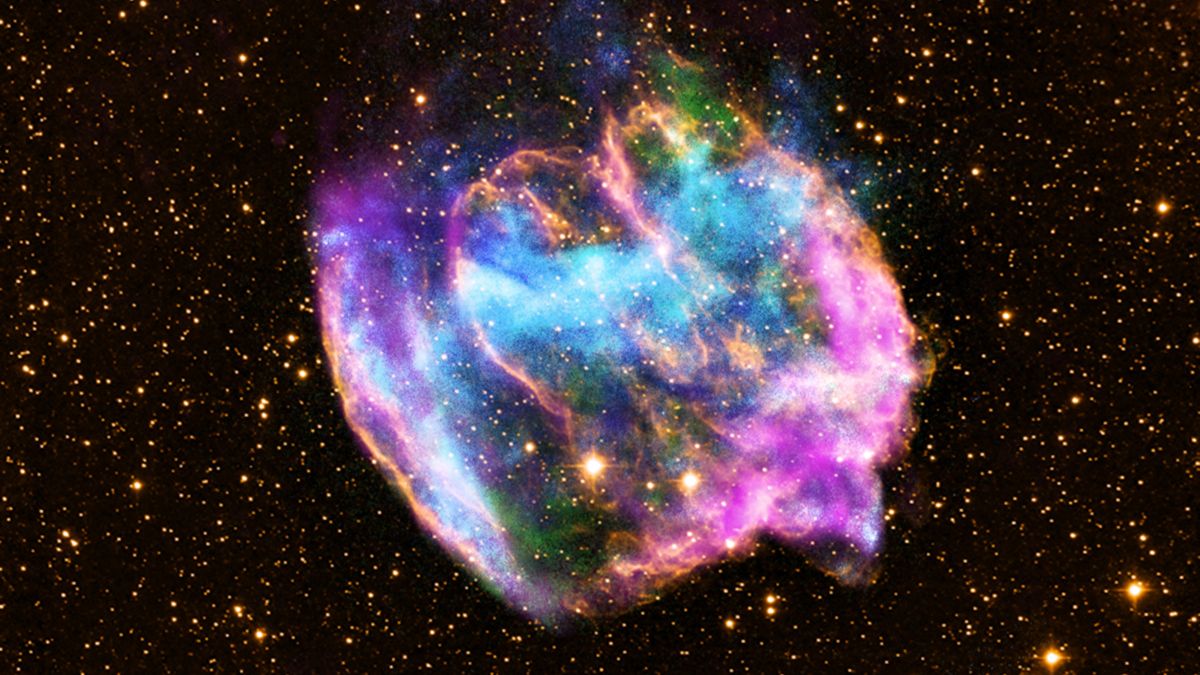
Wouldn’t it be nice to know when a giant star is about to die in a cataclysmic supernova explosion? A team of astronomers has done just that. If you see a giant red star surrounded by a thick shroud of material, watch out — the star will likely explode within a few years.
When a massive star approaches the end of its life, it goes through several violent phases. Deep in the star’s core, it shifts from fusing hydrogen to fusing heavier elements, starting with helium and moving up to carbon, oxygen, magnesium and silicon. At the end of the chain, the star eventually forms iron in its core. Because iron saps energy rather than releasing it, this spells the end for the star, and in less than a dozen minutes, it turns itself inside out in a fantastic explosion called a supernova.
But for all the commotion that goes on in the stars’ hearts, from the outside, it’s hard to tell exactly what’s going on. Sure, near the end of their lives, these giant stars swell to extreme sizes. They also become intensely bright — up to tens of thousands of times brighter than the sun. But because the stars’ surfaces are so distended, their outer temperatures actually drop, making them appear as red giants.
Related: James Webb Space Telescope detects a surprise supernova
The most famous example of such a near-terminal star is Betelgeuse. If it were placed within our solar system, this star — which is only 11 times more massive than the sun — would stretch to the orbit of Jupiter. It will go supernova any day now, but “any day” for an astronomer could be a million years away. Even though we know that these kinds of stars will eventually detonate in a supernova, there’s no way to get a more precise estimate than that. Or, at least, that used to be the case.
Ticking time bomb
Now, a team of astronomers has developed a way to spot supernovas that are likely to go off within a few years. They reported their results in a paper published to the preprint database arXiv and accepted for publication in the journal Monthly Notices of the Royal Astronomical Society.
They specifically studied a few dozen of a unique type of supernova known as Type II-P supernovae. In contrast to other supernovas, these explosions remain bright long after the initial outburst.
In a few examples, astronomers have looked back at old catalogs and found images of the stars before they exploded, and they all seem to be red supergiants like Betelgeuse. That’s a clear indication that those kinds of stars are supernova candidates, ready to go off at a moment’s notice.
The stars that result in these kinds of supernovas are thought to have dense shrouds of material surrounding them before they explode. These shrouds are orders of magnitude denser than what’s measured around Betelgeuse. It’s the heating of that material from the initial shock wave that causes the brightness to linger; there’s simply more stuff lying around to keep glowing well after the first sign of the explosion.
That dense shroud also causes this kind of supernova to become visible more rapidly than its more exposed cousins. When the explosion initially happens, the shock wave hits the material around the star, which causes the shock wave to lose steam as it passes through. While initially the energies from a supernova are enough to release high-energy radiation, like X-rays and gamma-rays, after the mixing of the shock wave and the surrounding material, the radiation given off is in optical wavelengths.
So it seems that these dense shrouds of material around the stars are also a giveaway that a supernova is about to happen.
Super cocoons
But how long does it take to form that shroud of material? The researchers studied two models. In one model, the star blew high-velocity winds from its surface, which slowly detached pieces of itself and spread it around to make the shroud over the course of decades. In the second model, the star suffered a violent pre-supernova explosion that sent gas weighing up to one-tenth the mass of the sun into orbit in less than a year.
Related stories:
The researchers then modeled how all that material would affect our images of the star. In either case, once the star built its shroud, it would be heavily obscured in a way that our current imaging technology could detect.
Because we have direct images of some of the pre-supernova stars taken less than 10 years before they went off, the astronomers concluded that the slow-and-steady model wouldn’t work. Otherwise, the star would have been obscured.
All this means that, once a supergiant star builds a thick shroud of material around itself, it is likely to go supernova within a few years. So, if you happen to be traveling through the cosmos and you come across this exact scenario, consider yourself warned.
Follow us on Twitter @Spacedotcom or on Facebook.



